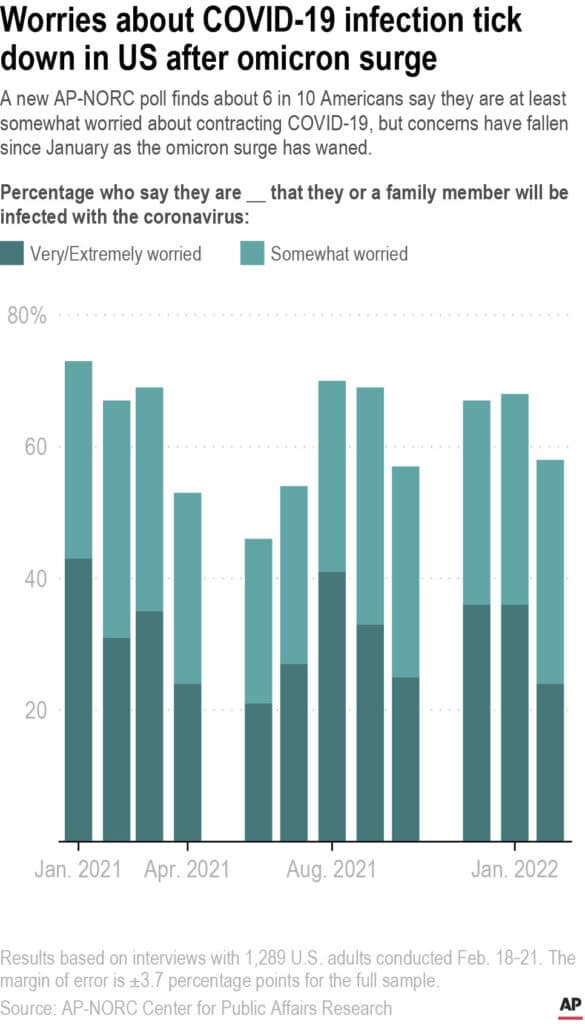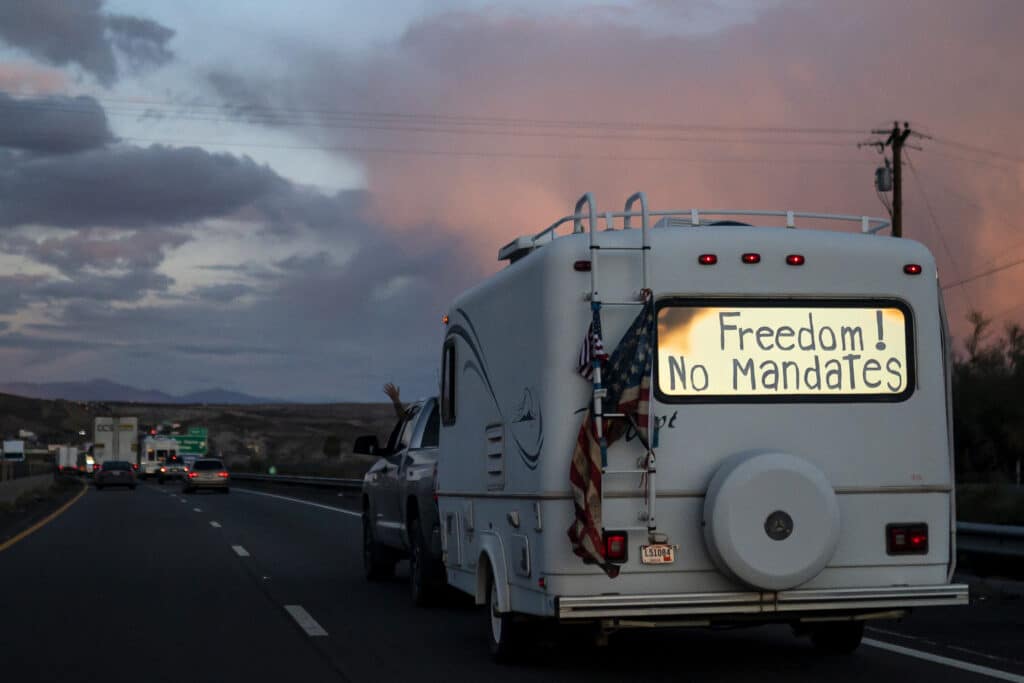A new poll found that very few Americans still fear COVID-19. Only 24% say they are “extremely” or “very” worried about themselves or a family member contracting COVID-19. The Associated Press has the story:
Signs the nation is ready to move on from COVID-19 wave are everywhere
Omicron is fading away, and so are Americans’ worries about COVID-19.
As coronavirus pandemic case numbers, hospitalizations and deaths continue to plummet, fewer people now than in January say they are concerned that they will be infected after the rise and fall of the wildly contagious virus variant, according to a new poll from The Associated Press-NORC Center for Public Affairs Research.
Just 24% say they are “extremely” or “very” worried about themselves or a family member contracting COVID-19, down from 36% in both December and January, when omicron caused a massive spike in infections and taxed public health systems. Another 34% say they are somewhat worried. More than 140,000 deaths in the U.S. have been attributed to COVID-19 since omicron became the dominant strain of the coronavirus in mid-December.

In Lincoln, Nebraska, trucking dispatcher Erica Martinez said she let down her guard last summer, before the deadly delta variant took hold, then “stopped doing a lot of the social stuff” when cases spiked again during successive waves of delta and omicron. Now, with virus numbers falling rapidly, she said she is more comfortable about socializing than she has been in months.
“I feel like the country is desperately trying to recover from the last two years,” said Martinez, 36. “I think there will always be new variants popping up, left and right. I think, sadly, this is going to be the new norm for society,” with people taking fewer or more precautions as cases ebb and flow.
That’s a widespread attitude; most Americans think the virus will stick around as a mild illness, according to a January AP-NORC poll. Just 15% think COVID-19 will largely be eliminated when the pandemic is over.
Signs the nation is ready to move on from the biggest COVID-19 wave to date are everywhere. Statewide mask mandates have all but disappeared, and on Friday, the Centers for Disease Control and Prevention said it’s no longer recommending indoor masking for most Americans, based on current data.
Cities are lifting vaccine requirements to enter bars, restaurants and entertainment venues. Companies are bringing workers back to the office. California said it’s taking an “endemic” approach to the virus that leans on prevention and swift containment of outbreaks.
“I think it’s reasonable and appropriate for people to live their lives a little more as the risk of infection goes down but to do it in a way that recognizes that, at some point, we’re going to have another wave,” said Dr. David Dowdy, an epidemiologist at the Johns Hopkins Bloomberg School of Public Health. “And we’re going to need to be willing to buckle down just a little bit in the future.”
Worries about infection have dipped among both vaccinated and unvaccinated Americans. Still, roughly two-thirds of vaccinated Americans say they are at least somewhat worried about COVID-19 infection. About 4 in 10 unvaccinated Americans say the same.
Amie Adkins, of Gassaway, West Virginia, who is unvaccinated, said she was “surrounded” by omicron but never worried about getting it, counting on a mask and good hygiene to protect herself. Data shows unvaccinated people are at much higher risk for serious illness and death than people who got the shot.
“Even after all that, if we’re going to get something, we’re going to get it, and there’s nothing we can do about. So there’s no use worrying about it,” said Adkins, a 43-year-old stay-at-home mom.
Public support for masking requirements also has ticked down, though Americans are still more likely to favor than oppose requiring masks in public, 50% to 28%, in the new poll. In August 2021, 55% were in favor. Support was much higher, at roughly three-quarters of the public, in 2020.
George Reeves, an 83-year-old semiretired electrical engineer in Raleigh, North Carolina, said his mask might soon come off.
“It’s a risk-reward kind of thing,” said Reeves, who is vaccinated. “There’s some guesswork involved, but is it worth the hassle? Probably pretty soon it won’t be worth the hassle of messing with masks.”
More broadly, concern about the spread of infectious diseases as a threat to the U.S. has fallen sharply from a clear majority just six months ago, according to the poll.
About half of Americans now say they are “extremely” or “very” concerned about the threat posed by infectious diseases, down from roughly two-thirds in August. Still, only about 2 in 10 are not concerned.
The current level of concern is similar to an AP-NORC poll in January 2019, well before the global pandemic.
Dave Pitts, a computer engineer and college math and science tutor in Denver, is vaccinated, doesn’t socialize much and wears a mask when he goes out, so he’s not that worried about getting COVID-19. But Pitts — who spent three miserable weeks battling influenza in the 2009 H1N1 pandemic — predicts infectious disease will continue to pose a huge threat to the country.
He worries about a new, even deadlier variant of the coronavirus.
“I think we’re in a better position now, but I think the minute spring break hits, we’re going to see something worse show up,” he said. “I think humanity’s too dumb to be free of this just yet.”
The U.S. is still reporting about 66,000 new, confirmed infections per day as the pandemic enters its third year.
In North Carolina, Reeves’ restaurant gift certificates have been collecting dust for two years. He said that will soon change as the virus eases its grip.
“After getting vaccinated, the probability of a bad result is really low. I’m reasonably well protected,” he said.
Martinez, the Nebraska transportation dispatcher, said she looks forward to “actually taking a vacation now, a vacation to try to feel as normal as possible. Maybe Mexico. Mexico sounds wonderful right now.”
By MICHAEL RUBINKAM and HANNAH FINGERHUT
The AP-NORC poll of 1,289 adults was conducted Feb. 18-21 using a sample drawn from NORC’s probability-based AmeriSpeak Panel, which is designed to be representative of the U.S. population. The margin of sampling error for all respondents is plus or minus 3.7 percentage points.







